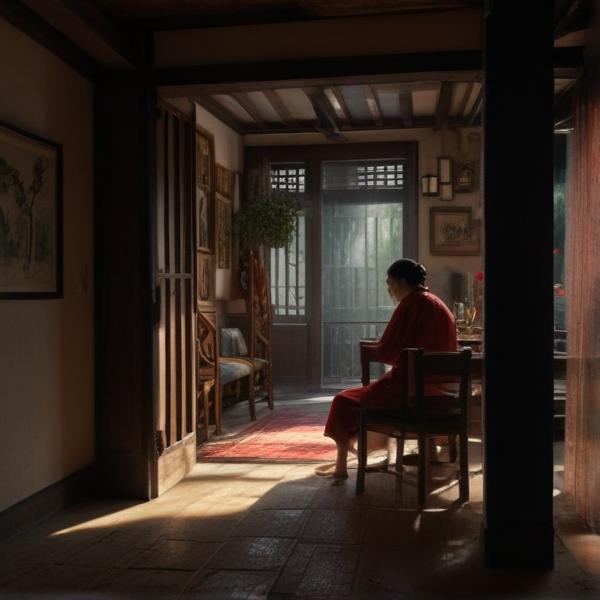基本信息 (Basic Information)
含义与用法 (Meanings & Usage)
中文核心释义 (Core Chinese Meaning): 横木、棍棒、杆子、支撑物;在现代口语中也引申为顶撞、抬杠。
英文核心释义 (Core English Meaning): horizontal bar, pole, rod; also used colloquially to mean to argue or contradict.
象形意义 / 为何这么写 (Pictographic Meaning / Writing Rationale)
文言文释义 (Classical Chinese Meaning)
与现代意义相近,多指横木、棍棒等。Similar to modern meaning, mostly referring to horizontal bars or rods.
深入学习 (In-depth Study)
字源故事 (Origin Story)
字形演变 (Character Evolution)
常用词语和例句 (Common Words & Examples)
单杠 (horizontal bar (gymnastics apparatus))
他在体育课上练习单杠。
Eng: He practices on the horizontal bar in P.E. class.
抬杠 (to argue for the sake of arguing; to bicker)
你别总和我抬杠。
Eng: Stop always arguing with me.
杠铃 (barbell)
这位运动员正在举杠铃。
Eng: The athlete is lifting the barbell.
相关成语 (Related Idioms)
相关成语信息待补充。Related idiom information pending.
多语言翻译 (核心释义) (Translations (Core Meaning))
- French: barre, barre horizontale
- German: Stange, Stab, Querbalken
- Spanish: barra, barra horizontal
- Italian: barra, asta, palo
- Portuguese: barra, barra horizontal
- Russian: перекладина, штанга
- Arabic: عارضة، قضيب أفقي
- Persian: میله، میله افقی
- Dutch: stang, horizontale balk
- Polish: drążek, belka
- Vietnamese: thanh ngang, đòn gánh
- Ukrainian: перекладина, жердина
视频学习资源 (Video Learning Resources)
通过以下链接在热门视频网站搜索 "杠" 的更多讲解:
Search for more explanations of "杠" on popular video sites:
- 在 Bilibili.com 搜索 "杠 字源 说文解字" (Search on Bilibili)
- 在 YouTube.com 搜索 "杠 character origin etymology" (Search on YouTube)
网络参考 (Web References for "杠") ()
网络内容摘要 (Web Content Summary):
核心含义及字源:“杠”是一个形声字,左边的“木”表示其与木头相关,右边的“工”作声符。本义是“床前的一根横木”,即床前用来支撑或加固的横木。在古代文献如《说文解字》中有记载。 Core Meaning & Etymology: "杠" is a phono-semantic character: the radical "木" (wood) indicates its relation to wood, and "工" suggests its pronunciation. Its original meaning is "the crosspiece of wood at the front of a bed", as described in ancient dictionaries like Shuowen Jiezi.
文化与区域差异: 在不同地区,这种“牀前横木”有不同的名称。例如,在北燕、朝鲜一带称为“树”,秦晋一带称为“杠”,南楚一带叫“赵”,东齐称为“𣘘”。 Cultural & Regional Usage: Different regions had different names for this bed crosspiece. For example, in Northern Yan and Korea, it was called "树"; in Qin and Jin, "杠"; in Southern Chu, "赵"; and in Eastern Qi, "𣘘".
- 引申及常用义:后来“杠”引申为横着的木棍或横梁,也泛指任何形式的横木,有时亦可用作“桥”(如横在水上的木桥)。 Extended & Common Usages: "杠" later referred to any crossbeam or horizontal bar, sometimes even a "bridge" when used for wooden footbridges.
- 现代词汇与成语:现代汉语中“杠”常见于“杠杆”(lever)、“抬杠”(bicker, argue for arguing's sake)等词语,中性或引申为“争论”。 Modern Words & Idioms: Common usage includes "杠杆" (lever) and "抬杠" (to bicker or argue). The meaning can be neutral or refer to arguing persistently.
- 易混淆之处:“杠”(gāng)与“杆”(gǎn, gān,指棍子、竿子)容易混淆。注意其读音和具体用法的差别。 Easy Confusion: "杠" (gāng) is easily confused with "杆" (gǎn, gān, meaning rod or pole). Take care with pronunciation and context.
总结:“杠”本义为牀前横木,后泛指各种横木或横梁。在现代中文里,“杠”还可指代争论、杠杆等。学习时注意与“杆”等相似字区别。 Summary: "杠" originally meant the crosspiece at the front of a bed, later referring to any crossbar or beam. In modern usage, it appears in words like "lever" or "to argue". Distinguish it from similar characters such as "杆".
杠(汉语文字)_百度百科
(杠)牀前横木也。方言曰。牀其杠、北燕朝鲜之闲谓之树。自关而西秦晋之闲谓之杠。 南楚 之闲谓之赵。东齐海岱之闲谓之𣘘。按 广韵 作牀前横。无木字。然则 横读 古旷反。 孟子 徒杠。其引伸之义也。 尔雅 。素锦韬杠。丨部曰。?、旌旗杠儿则谓直者 ...
汉字"杠"的起源、演变过程-汉字字源辞典
汉字字源辞典收录2976条汉字词条,基本涵盖了常见汉字的字源解析,是汉字研究的必备工具。 ... 【简繁关系】"杠"是形声字,形符是木,声符是工,本读gāng,义为床前横木。《说文·木部》:"杠,牀前横木也。"又义为桥。
更多图片 (杠 More Images) ()
